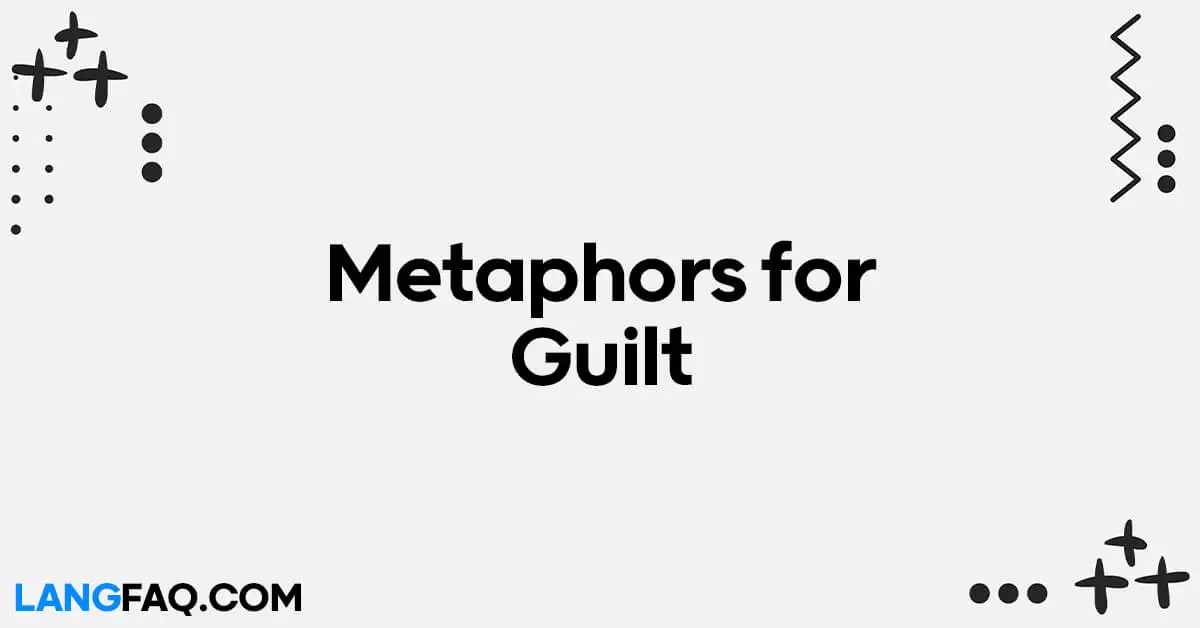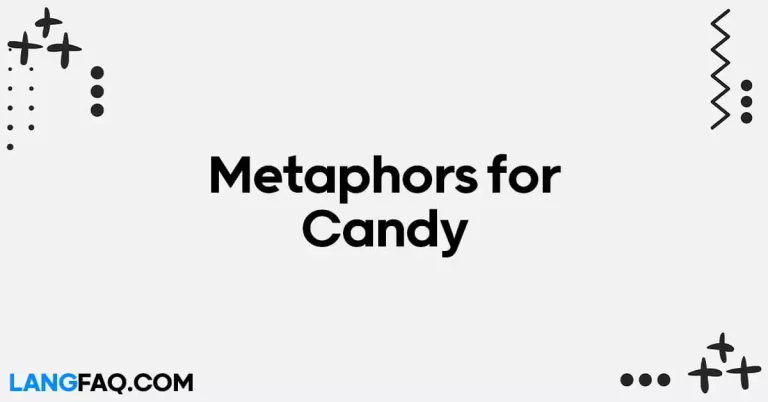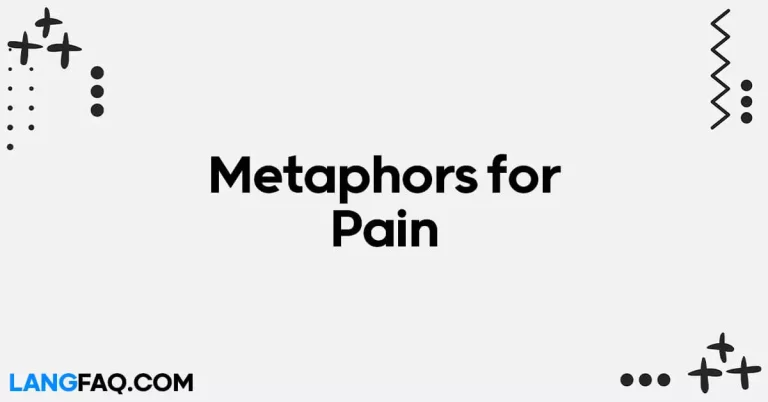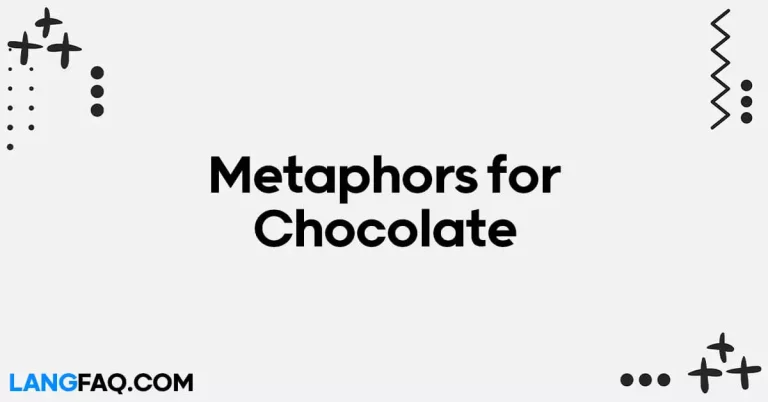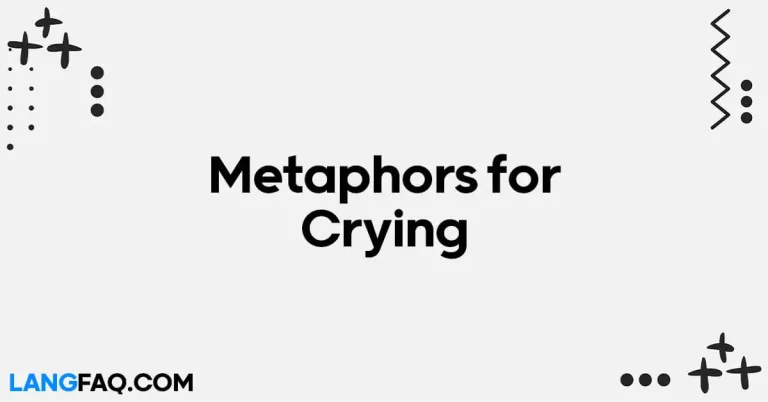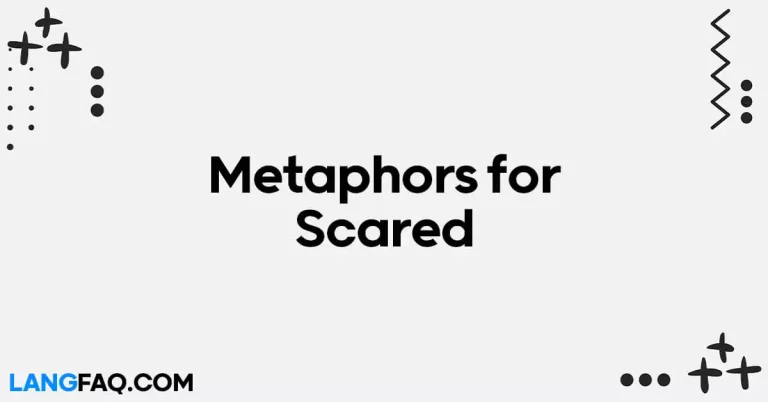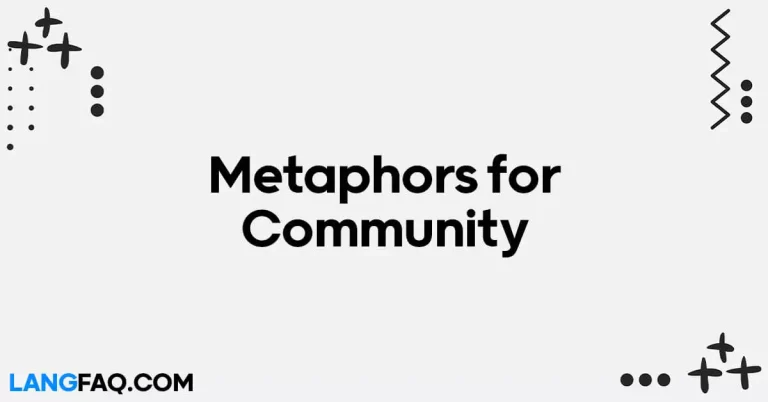Guilt, a complex emotion woven into the fabric of human experience, manifests in various metaphors that reflect its nuanced nature. In this exploration, we unravel 26 metaphors for guilt, shedding light on the intricacies and depth of this universal emotion.
26 Metaphors for Guilt
- The Heavy Chain: Guilt is like a heavy chain, binding us to our past mistakes and weighing down our spirit.
- The Poisoned Well: Just as a poisoned well taints the water, guilt contaminates our thoughts and emotions.
- The Lingering Fog: Guilt settles like a lingering fog, clouding our judgment and obscuring the path to clarity.
- The Echoing Footsteps: The footsteps of guilt echo through our conscience, a constant reminder of the paths we shouldn’t have taken.
- The Hidden Thorn: Like a hidden thorn, guilt pricks at our consciousness, causing discomfort with every recollection of wrongdoing.
- The Shadowed Sun: Guilt casts a shadow over our happiness, dimming the sunlight of joy with the clouds of remorse.
- The Unseen Shackles: Unseen but potent, guilt binds us in invisible shackles, restricting our freedom and peace of mind.
- The Broken Compass: Guilt acts as a broken compass, leading us astray and making it challenging to find our moral north.
- The Weeping Willow: Much like the weeping willow, guilt’s tendrils reach deep within, causing a cascade of emotional tears.
- The Silent Alarm: Guilt functions as a silent alarm, alerting us to the moral trespasses that demand our attention.
- The Stifled Cry: Guilt is a stifled cry within, a suppressed expression of remorse that yearns for release.
- The Scarlet Stain: Akin to a scarlet stain, guilt leaves a visible mark on our conscience, a reminder of our moral imperfections.
- The Sinking Ship: Guilt sinks our emotional vessel, leaving us to navigate the turbulent waters of remorse.
- The Veiled Mirror: Guilt veils the mirror of self-reflection, distorting the image we see and fostering self-deception.
- The Wounded Bird: Guilt is a wounded bird within, its injured wings symbolizing the harm caused by our actions.
- The Unforgiving Judge: Guilt takes on the role of an unforgiving judge, passing sentences of remorse and self-condemnation.
- The Quicksand Trap: Like quicksand, guilt ensnares us, making it difficult to escape the sinking feeling of culpability.
- The Haunting Melody: Guilt plays a haunting melody in the background of our thoughts, a constant reminder of our moral discord.
- The Cracked Mirror: Guilt shatters the mirror of self-esteem, leaving behind fragmented reflections of our damaged morality.
- The Burdened Backpack: Guilt is a heavy backpack we carry, filled with the weight of our wrongdoings and missed opportunities.
- The Darkened Beacon: Guilt dims the beacon of our inner light, making it challenging to find our way back to moral clarity.
- The Unfinished Puzzle: Guilt is an unfinished puzzle, with missing pieces representing unresolved emotions and actions.
- The Fading Star: Guilt dims our internal star, diminishing the brightness of our inherent goodness.
- The Crooked Compass: Much like a crooked compass, guilt leads us down a morally skewed path, away from true north.
- The Tangled Web: Guilt weaves a tangled web, ensnaring us in the complexity of our moral dilemmas.
- The Closed Door: Guilt is a closed door within us, preventing the entry of peace and contentment until it is opened and addressed.
| Metaphor | Meaning | Example |
|---|---|---|
| The Heavy Chain | Binding influence of guilt on our past actions | The heavy chain of guilt kept me from moving forward. |
| The Poisoned Well | Contamination of thoughts and emotions by guilt | Guilt flowed through me like water from a poisoned well. |
| The Lingering Fog | Persistent clouding of judgment by guilt | The lingering fog of guilt obscured my decision-making. |
| The Echoing Footsteps | Constant reminder of past mistakes | The echoing footsteps of guilt followed me everywhere. |
| The Hidden Thorn | Unseen discomfort caused by guilt | Guilt pricked at my conscience like a hidden thorn. |
| The Shadowed Sun | Dimming of joy and happiness by guilt | Guilt cast a shadow over my life like a clouded sun. |
| The Unseen Shackles | Invisible restrictions imposed by guilt | I felt the unseen shackles of guilt holding me back. |
| The Broken Compass | Misguidance and moral confusion by guilt | Guilt acted as a broken compass, leading me astray. |
| The Weeping Willow | Emotional cascade triggered by guilt | Guilt’s tendrils within me were like a weeping willow. |
| The Silent Alarm | Quiet but urgent alert to moral transgressions | Guilt served as a silent alarm, awakening my conscience. |
| The Stifled Cry | Suppressed expression of remorse | Inside, a stifled cry of guilt yearned for release. |
| The Scarlet Stain | Visible mark left by guilt on the conscience | The scarlet stain of guilt marked my moral missteps. |
| The Sinking Ship | Emotional descent caused by guilt | Guilt turned my emotional vessel into a sinking ship. |
| The Veiled Mirror | Distorted self-reflection due to guilt | Guilt veiled the mirror, making self-reflection unclear. |
| The Wounded Bird | Symbolic harm within caused by guilt | Guilt wounded me like a bird with injured wings. |
| The Unforgiving Judge | Harsh self-condemnation and remorse | Guilt assumed the role of an unforgiving judge. |
| The Quicksand Trap | Entrapment in guilt, difficult to escape | Guilt felt like quicksand, pulling me deeper. |
| The Haunting Melody | Persistent and haunting reminder of guilt | In my mind, guilt played a haunting melody. |
| The Cracked Mirror | Shattered self-esteem due to guilt | Guilt shattered my self-esteem like a cracked mirror. |
| The Burdened Backpack | Weight of guilt carried in daily life | Guilt was a heavy backpack, burdening my every step. |
| The Darkened Beacon | Diminished inner light due to guilt | Guilt dimmed the beacon of my inner light. |
| The Unfinished Puzzle | Incomplete resolution of guilt-related emotions | Guilt left me feeling like an unfinished puzzle. |
| The Fading Star | Diminishing inherent goodness due to guilt | Guilt dimmed the brightness of my internal star. |
| The Crooked Compass | Moral misdirection caused by guilt | Guilt acted as a crooked compass, leading me astray. |
| The Tangled Web | Complexity of moral dilemmas caused by guilt | Guilt wove a tangled web of moral challenges. |
| The Closed Door | Prevention of peace and contentment by guilt | Guilt was a closed door, blocking my inner tranquility. |
This table of 26 metaphors for guilt provides a vivid exploration of the multifaceted nature of this complex emotion. Each metaphor unveils a unique facet, illustrating how guilt can manifest as a heavy burden, a haunting presence, or a distorted reflection.
Together, these metaphors paint a comprehensive picture, capturing the intricacies and depth of the human experience with guilt. As we navigate the metaphoric landscape, we gain insights into the emotional weight, the lingering impact, and the challenging journey toward redemption that guilt often entails.
The Heavy Chain: Navigating the Weight of Guilt
Guilt, akin to a heavy chain, can profoundly impact our emotional well-being, dragging us into the depths of remorse and self-reflection. Understanding the weight of this metaphor provides a key to unlocking the complexities of guilt.
When to Use:
- Formal Context (Colleagues): Discussing the emotional toll of a professional mistake.
- Informal Context (Friends): Sharing personal struggles and seeking empathy.
Example:
Email to a Colleague: Subject: Acknowledging Recent Mistakes
Dear [Colleague’s Name],
I hope this message finds you well. I wanted to address recent setbacks in our project. The weight of these challenges feels like a heavy chain, and I am committed to rectifying the situation promptly. Your insights would be invaluable as we navigate this together.
Best regards, [Your Name]
Text to a Friend: Hey [Friend’s Name],
I’ve been carrying the heavy chain of guilt lately for missing our last meet-up. Let’s catch up this weekend and break free from this weight.
Cheers, [Your Name]
Pros and Cons:
Pros:
- Evokes a strong visual image of the burden of guilt.
- Suitable for expressing deep remorse in various contexts.
Cons:
- May convey a sense of being overwhelmed, potentially intensifying the emotional impact.
Grammar/Usage Tips:
- Use in situations where the gravity of guilt needs emphasis.
- Ensure a balance between expressing remorse and seeking resolution.
Dictionary Insight:
Cambridge Dictionary defines “heavy chain” metaphorically as something that restricts or limits freedom, which aligns with the emotional constraints of guilt.
The Poisoned Well: Understanding the Contamination of Guilt
Imagine guilt as a poisoned well, tainting our thoughts and emotions. Exploring this metaphor unveils the profound influence guilt can have on our mental landscape.
When to Use:
- Formal Context (Mentor-Mentee): Guiding someone through the aftermath of a mistake.
- Informal Context (Family): Discussing the impact of personal actions on loved ones.
Example:
Conversation with a Mentor: Mentor: It’s essential to address the consequences of the error, but be cautious not to let guilt become a poisoned well. Learn from it without letting it contaminate your future decisions.
Family Discussion: Family Member: I understand the situation was tough, but we can’t let guilt turn our minds into a poisoned well. We’ll work through this together.
Pros and Cons:
Pros:
- Emphasizes the potential long-term impact of guilt.
- Encourages a focus on learning and growth.
Cons:
- May highlight the lasting effects of guilt, which could be daunting.
Grammar/Usage Tips:
- Ideal for discussions about the lasting impact of guilt.
- Use in contexts where learning from mistakes is crucial.
Dictionary Insight:
The Cambridge Dictionary suggests that a “poisoned well” can represent a situation that has become dangerous or harmful, aligning with the metaphorical contamination caused by guilt.
The Lingering Fog: Guilt’s Effect on Judgment
Guilt, like a lingering fog, clouds our judgment and obscures the path to clarity. Exploring this metaphor provides insights into how guilt can affect decision-making.
When to Use:
- Formal Context (Team Discussion): Addressing the impact of guilt on decision-making processes.
- Informal Context (Self-Reflection): Journaling about personal experiences to gain clarity.
Example:
Team Meeting Discussion: Team Lead: Let’s acknowledge any lingering fog caused by guilt in our decision-making. It’s crucial to ensure our choices are guided by clarity, not emotional baggage.
Journal Entry: Today, the lingering fog of guilt made it challenging to make decisions confidently. I’ll take a moment to reflect and regain clarity.
Pros and Cons:
Pros:
- Draws attention to the potential clouding effect of guilt.
- Encourages individuals to assess their decision-making process.
Cons:
- May imply a temporary state of confusion, which could be unsettling.
Grammar/Usage Tips:
- Effective in contexts where decision-making is a central theme.
- Encourage a proactive approach to addressing guilt-induced fog.
Dictionary Insight:
Cambridge Dictionary defines “lingering” as staying longer than usual, aligning with the idea of guilt’s persistence and impact on judgment.
The Echoing Footsteps: Constant Reminders of Past Mistakes
Guilt’s metaphorical echoing footsteps serve as a constant reminder of our past mistakes, influencing our present actions and future decisions. Unveiling this metaphor provides a deeper understanding of how guilt can shape our journey toward redemption.
When to Use:
- Formal Context (Reflection Workshop): Facilitating discussions on learning from past errors.
- Informal Context (Friend’s Advice): Offering guidance on overcoming guilt to a friend.
Example:
Workshop Facilitator: Let’s explore the echoing footsteps of guilt and how they impact our choices. Understanding these echoes allows us to navigate our path with greater awareness and resilience.
Advice to a Friend: Friend: I get it; guilt’s echoing footsteps can be tough. Remember, they guide your steps toward growth, not just dwell on past missteps.
Pros and Cons:
Pros:
- Highlights the ongoing impact of guilt.
- Encourages introspection and learning from past experiences.
Cons:
- May imply a continuous, sometimes intrusive, influence of guilt.
Grammar/Usage Tips:
- Ideal for discussions about the lasting impact of guilt.
- Encourage a proactive approach to addressing guilt-induced echoes.
Dictionary Insight:
The term “echoing” from Cambridge Dictionary suggests a repetition of a sound, aligning with the persistent reminders and influence of guilt.
The Hidden Thorn: Unseen Discomfort Caused by Guilt
Guilt, much like a hidden thorn, can cause discomfort beneath the surface, subtly affecting our thoughts and emotions. Exploring this metaphor unveils the nuanced aspects of guilt that may not always be visible.
When to Use:
- Formal Context (Therapeutic Setting): Discussing the subtler impacts of guilt on mental well-being.
- Informal Context (Personal Reflection): Journaling about hidden emotions caused by guilt.
Example:
Therapist Session: Client: It’s like a hidden thorn, this guilt. It’s there, and I feel it, even if others don’t. How do I pull it out without causing more pain?
Personal Journal Entry: Today, I realized guilt is a hidden thorn. Its presence is subtle, but the discomfort is undeniable. Time to address it head-on.
Pros and Cons:
Pros:
- Sheds light on the often unseen discomfort caused by guilt.
- Prompts individuals to acknowledge hidden emotions.
Cons:
- May evoke a sense of discomfort and vulnerability.
Grammar/Usage Tips:
- Suitable for discussions about the subtle impacts of guilt.
- Encourage a gentle approach to addressing hidden emotions.
Dictionary Insight:
The term “hidden” from Cambridge Dictionary implies not easily seen, aligning with the idea that guilt’s impact may be subtle and concealed.
The Shadowed Sun: Dimming of Joy and Happiness by Guilt
Guilt, metaphorically casting a shadow over our lives like a clouded sun, can diminish the brightness of joy and happiness. Delving into this metaphor provides insights into how guilt can influence our emotional landscape.
When to Use:
- Formal Context (Emotional Wellness Seminar): Addressing the impact of guilt on overall well-being.
- Informal Context (Apology to a Friend): Expressing regret for actions that affected a friend’s happiness.
Example:
Seminar Speaker: Guilt acts as a shadow on the canvas of our emotions, dimming the sunlight of joy. Let’s explore strategies to bring back the brightness.
Apology to a Friend: Friend: Your apology means a lot. It’s like lifting the shadowed sun; I can feel the warmth returning to our friendship.
Pros and Cons:
Pros:
- Illustrates the impact of guilt on emotional well-being.
- Encourages strategies for restoring joy.
Cons:
- May convey a sense of darkness and emotional struggle.
Grammar/Usage Tips:
- Effective when discussing the emotional toll of guilt.
- Encourage actions that bring back brightness and joy.
Dictionary Insight:
The term “shadowed” from Cambridge Dictionary suggests being covered in shadow, aligning with the metaphor of guilt casting a shadow over happiness.
The Unseen Shackles: Navigating Invisible Restrictions
Guilt, like unseen shackles, imposes invisible restrictions on our freedom and peace of mind. Unraveling this metaphor provides a deeper understanding of how guilt can constrain our emotional and mental well-being.
When to Use:
- Formal Context (Rehabilitation Program): Discussing the emotional impact of guilt on individuals seeking recovery.
- Informal Context (Personal Growth Journaling): Reflecting on the constraints of guilt in personal development.
Example:
Rehabilitation Counselor: Guilt can feel like unseen shackles, limiting your sense of freedom. Recognizing and addressing these emotional constraints is a crucial step in your journey towards recovery.
Personal Journal Entry: Today, I realized guilt had become my unseen shackles, constraining my ability to move forward. Time to break free.
Pros and Cons:
Pros:
- Highlights the invisible yet powerful nature of guilt.
- Encourages individuals to recognize and address emotional constraints.
Cons:
- May evoke a sense of confinement and emotional struggle.
Grammar/Usage Tips:
- Ideal for discussions about emotional constraints and personal growth.
- Encourage a proactive approach to breaking free from guilt-induced shackles.
Dictionary Insight:
The term “unseen” from Cambridge Dictionary implies not seen or noticed, aligning with the idea that guilt’s impact may not always be apparent.
The Broken Compass: Misguidance and Moral Confusion
Guilt, acting as a broken compass, can lead us astray, creating moral confusion and uncertainty. Exploring this metaphor provides insights into how guilt can impact our sense of direction in decision-making.
When to Use:
- Formal Context (Ethics Workshop): Discussing the role of guilt in ethical decision-making.
- Informal Context (Friend’s Advice): Offering guidance on navigating moral dilemmas.
Example:
Ethics Workshop Facilitator: Guilt can act as a broken compass, clouding our ethical judgment. Let’s explore strategies to mend the compass and regain moral clarity.
Advice to a Friend: Friend: I get it; guilt can be like a broken compass. Take a step back, reassess your values, and let that guide your decisions.
Pros and Cons:
Pros:
- Illustrates the potential misguidance caused by guilt.
- Encourages strategies for regaining moral clarity.
Cons:
- May convey a sense of moral confusion and uncertainty.
Grammar/Usage Tips:
- Effective in discussions about ethics and moral decision-making.
- Encourage actions that align with one’s values to mend the broken compass.
Dictionary Insight:
The term “broken” from Cambridge Dictionary suggests having been damaged or no longer in one piece, aligning with the metaphor of guilt as a broken compass leading to moral confusion.
The Weeping Willow: Emotional Cascade Triggered by Guilt
Guilt, much like the branches of a weeping willow, can trigger an emotional cascade, leading to a profound expression of sorrow and remorse. Delving into this metaphor provides insights into how guilt can influence our emotional landscape.
When to Use:
- Formal Context (Therapeutic Intervention): Addressing the emotional release triggered by guilt.
- Informal Context (Personal Reflection): Exploring the emotional impact of guilt through writing or self-expression.
Example:
Therapist Session: The weeping willow metaphor encapsulates the emotional cascade triggered by guilt. Let’s explore healthy outlets for expressing and processing these intense emotions.
Personal Journal Entry: Today, guilt felt like a weeping willow, its branches releasing a cascade of emotions. Writing this down allows me to understand and process these feelings.
Pros and Cons:
Pros:
- Evokes a strong visual image of the emotional impact of guilt.
- Encourages individuals to find healthy outlets for emotional release.
Cons:
- May convey a sense of intense emotional turmoil.
Grammar/Usage Tips:
- Suitable for discussions about the emotional release triggered by guilt.
- Encourage healthy outlets for processing intense emotions.
Dictionary Insight:
The term “weeping” from Cambridge Dictionary suggests shedding tears, aligning with the metaphor of guilt triggering an emotional cascade.
The Silent Alarm: Urgent Alerts to Moral Transgressions
Guilt, operating as a silent alarm, quietly alerts us to moral transgressions, demanding our attention to rectify and learn from our actions. Exploring this metaphor unveils the subtle yet powerful role guilt plays in guiding our moral compass.
When to Use:
- Formal Context (Ethics Training): Discussing the role of guilt as an ethical guide.
- Informal Context (Friend’s Insight): Reflecting on the importance of moral introspection.
Example:
Ethics Trainer: Think of guilt as a silent alarm, urging you to pause and reflect on your actions. Let it guide you toward ethical choices and continuous improvement.
Conversation with a Friend: Friend: Guilt is like a silent alarm, isn’t it? It’s our conscience nudging us to be better.
Pros and Cons:
Pros:
- Emphasizes the subtlety and importance of guilt.
- Encourages moral introspection and continuous improvement.
Cons:
- May imply a sense of urgency, which could be overwhelming.
Grammar/Usage Tips:
- Ideal for discussions about ethical decision-making.
- Encourage individuals to listen to the silent alarm and take positive actions.
Dictionary Insight:
The term “silent” from Cambridge Dictionary suggests making no sound, aligning with the metaphor of guilt quietly signaling moral transgressions.
The Stifled Cry: Suppressed Expression of Remorse
Guilt, akin to a stifled cry within, represents a suppressed expression of remorse yearning for release. Delving into this metaphor provides insights into the internal struggles individuals face when dealing with guilt.
When to Use:
- Formal Context (Counseling Session): Addressing the emotional suppression caused by guilt.
- Informal Context (Self-Reflection): Exploring personal emotions related to guilt.
Example:
Counselor Session: Guilt may manifest as a stifled cry within, a suppressed expression of remorse. Let’s work together to provide a healthy outlet for this emotional release.
Personal Reflection: Today, I realized guilt is like a stifled cry within me. It’s time to acknowledge and express these feelings, allowing for emotional healing.
Pros and Cons:
Pros:
- Highlights the internal emotional struggle associated with guilt.
- Encourages individuals to find healthy outlets for emotional expression.
Cons:
- May convey a sense of emotional suppression.
Grammar/Usage Tips:
- Suitable for discussions about emotional expression and release.
- Encourage individuals to acknowledge and express their feelings surrounding guilt.
Dictionary Insight:
The term “stifled” from Cambridge Dictionary suggests restrained or suppressed, aligning with the metaphor of guilt as a stifled cry.
The Scarlet Stain: Visible Mark on the Conscience
Guilt, metaphorically a scarlet stain, leaves a visible mark on our conscience, a constant reminder of our moral missteps. Unraveling this metaphor provides insights into the lasting impact of guilt on our self-perception.
When to Use:
- Formal Context (Restorative Justice Program): Discussing the impact of guilt on personal growth and accountability.
- Informal Context (Apology Letter): Expressing remorse for actions that left a lasting mark.
Example:
Restorative Justice Facilitator: Think of guilt as a scarlet stain; it leaves a visible mark on your conscience. Embrace this mark as a catalyst for growth and accountability.
Apology Letter Excerpt: I acknowledge the scarlet stain my actions left on our relationship. My sincere apologies for the pain I’ve caused, and I am committed to making amends.
Pros and Cons:
Pros:
- Illustrates the lasting impact and accountability associated with guilt.
- Encourages personal growth and amends.
Cons:
- May convey a sense of permanence and weight.
Grammar/Usage Tips:
- Effective when discussing personal growth and accountability.
- Encourage individuals to embrace the scarlet stain as a catalyst for positive change.
Dictionary Insight:
The term “scarlet” from Cambridge Dictionary suggests a bright red color, aligning with the metaphor of guilt as a scarlet stain, symbolizing visibility and intensity.
The Sinking Ship: Emotional Descent Caused by Guilt
Guilt, likened to a sinking ship, submerges our emotional vessel and challenges our ability to navigate the turbulent waters of remorse. Delving into this metaphor provides insights into the emotional descent caused by the weight of guilt.
When to Use:
- Formal Context (Therapeutic Workshop): Addressing the emotional impact of guilt on mental well-being.
- Informal Context (Apology to a Loved One): Expressing remorse for actions that strained a relationship.
Example:
Therapist Workshop: Guilt can feel like a sinking ship, pulling us into the depths of emotional turmoil. Let’s explore strategies to navigate these waters and resurface stronger.
Apology to a Loved One: I understand my actions caused our relationship to feel like a sinking ship. I am committed to rebuilding and sailing towards calmer waters.
Pros and Cons:
Pros:
- Evokes a powerful image of emotional descent caused by guilt.
- Encourages individuals to navigate emotional challenges with resilience.
Cons:
- May convey a sense of emotional turmoil and struggle.
Grammar/Usage Tips:
- Suitable for discussions about emotional resilience.
- Encourage actions that promote emotional healing and rebuilding.
Dictionary Insight:
The term “sinking” from Cambridge Dictionary suggests descending or submerging, aligning with the metaphor of guilt as a sinking ship in emotional waters.
The Veiled Mirror: Distorted Self-Reflection Due to Guilt
Guilt, acting as a veiled mirror, distorts our self-reflection, making it challenging to perceive ourselves accurately. Exploring this metaphor provides insights into how guilt can affect our self-perception.
When to Use:
- Formal Context (Self-Reflection Seminar): Discussing the impact of guilt on self-awareness.
- Informal Context (Friend’s Support): Offering guidance to a friend struggling with self-perception.
Example:
Seminar Speaker: Guilt can be like a veiled mirror, distorting how we see ourselves. Let’s explore techniques to unveil the truth behind the veil and foster accurate self-reflection.
Supportive Conversation with a Friend: Friend: I know guilt has veiled your self-perception lately. Remember, you’re more than your mistakes; don’t let guilt distort your view.
Pros and Cons:
Pros:
- Illustrates the challenge of accurate self-reflection caused by guilt.
- Encourages techniques to unveil the truth behind the veil.
Cons:
- May convey a sense of distortion and self-deception.
Grammar/Usage Tips:
- Effective in discussions about self-awareness and overcoming guilt’s impact.
- Encourage individuals to foster accurate self-reflection despite the challenges posed by guilt.
Dictionary Insight:
The term “veiled” from Cambridge Dictionary suggests covered or concealed, aligning with the metaphor of guilt as a veiled mirror distorting self-reflection.
The Wounded Bird: Symbolic Harm Within Caused by Guilt
Guilt, metaphorically a wounded bird within, symbolizes the internal harm inflicted by our actions. Unraveling this metaphor provides insights into the emotional wounds caused by guilt.
When to Use:
- Formal Context (Rehabilitation Program): Discussing the emotional impact of guilt on individuals seeking recovery.
- Informal Context (Personal Growth Journaling): Reflecting on the internal harm caused by guilt.
Example:
Rehabilitation Counselor: Guilt may manifest as a wounded bird within, symbolizing the internal harm. Let’s work together to heal these emotional wounds and foster recovery.
Personal Journal Entry: Today, I acknowledged the wounded bird of guilt within me. It’s time to mend these emotional wounds and strive for personal growth.
Pros and Cons:
Pros:
- Evokes a poignant image of symbolic harm caused by guilt.
- Encourages individuals to address emotional wounds and embark on a journey of healing.
Cons:
- May convey a sense of internal struggle and vulnerability.
Grammar/Usage Tips:
- Suitable for discussions about emotional healing and recovery.
- Encourage actions that promote self-care and emotional well-being.
Dictionary Insight:
The term “wounded” from Cambridge Dictionary suggests being injured or harmed, aligning with the metaphor of guilt as a wounded bird symbolizing internal harm.
The Ghostly Echo: Lingering Presence of Guilt
Guilt, akin to a ghostly echo, haunts our thoughts, persistently reminding us of past actions. Delving into this metaphor provides insights into the enduring presence and impact of guilt on our consciousness.
When to Use:
- Formal Context (Psychological Counseling): Addressing the lingering effects of guilt on mental well-being.
- Informal Context (Supportive Conversation): Offering guidance to a friend grappling with persistent guilt.
Example:
Psychologist Session: The ghostly echo of guilt can linger, affecting our daily thoughts. Let’s explore coping mechanisms to manage and eventually release this haunting presence.
Supportive Conversation: Friend: I sense the ghostly echo of guilt is affecting you. Remember, acknowledging it is the first step to finding peace.
Pros and Cons:
Pros:
- Evokes a haunting image of guilt’s enduring presence.
- Encourages individuals to confront and manage persistent guilt.
Cons:
- May convey a sense of haunting and emotional weight.
Grammar/Usage Tips:
- Suitable for discussions about coping with persistent guilt.
- Encourage actions that promote self-forgiveness and emotional release.
Dictionary Insight:
The term “ghostly” from Cambridge Dictionary suggests resembling or characteristic of a ghost, aligning with the metaphor of guilt as a ghostly echo lingering in our thoughts.
The Tangled Web: Complex Interplay of Guilt and Relationships
Guilt, metaphorically a tangled web, intricately weaves into our relationships, influencing dynamics and interactions. Exploring this metaphor provides insights into the complexities of guilt within the context of connections with others.
When to Use:
- Formal Context (Relationship Counseling): Discussing the impact of guilt on interpersonal relationships.
- Informal Context (Family Dialogue): Navigating the complexities of guilt within a familial context.
Example:
Relationship Counselor: Think of guilt as a tangled web in your relationships. Untangling it requires open communication, empathy, and a shared commitment to understanding each other’s perspectives.
Family Discussion: Family Member: Our interactions have become a bit like a tangled web lately, haven’t they? Let’s address the guilt and work towards untangling the knots for a healthier dynamic.
Pros and Cons:
Pros:
- Illustrates the intricate interplay of guilt within relationships.
- Encourages open communication and understanding.
Cons:
- May convey a sense of complexity and challenge.
Grammar/Usage Tips:
- Effective when discussing the impact of guilt on interpersonal dynamics.
- Encourage actions that foster open communication and mutual understanding.
Dictionary Insight:
The term “tangled” from Cambridge Dictionary suggests twisted or knotted together, aligning with the metaphor of guilt as a tangled web within relationships.
The Chained Wings: Impact of Guilt on Personal Freedom
Guilt, like chained wings, restricts our personal freedom, hindering our ability to soar without the weight of remorse. Delving into this metaphor provides insights into how guilt can affect our sense of autonomy and liberation.
When to Use:
- Formal Context (Personal Development Workshop): Discussing the impact of guilt on individual growth.
- Informal Context (Friend’s Advice): Offering guidance to a friend seeking personal freedom from guilt.
Example:
Workshop Facilitator: Imagine guilt as chained wings; they limit your ability to fly freely. Let’s explore strategies to unshackle these chains and embrace personal growth.
Friend’s Advice: Friend: I see your guilt as those chained wings. It’s time to break free and soar without the weight of remorse holding you back.
Pros and Cons:
Pros:
- Emphasizes the impact of guilt on personal freedom and growth.
- Encourages individuals to seek liberation from guilt.
Cons:
- May convey a sense of constraint and emotional weight.
Grammar/Usage Tips:
- Suitable for discussions about personal development and breaking free from guilt.
- Encourage actions that promote self-forgiveness and personal liberation.
Dictionary Insight:
The term “chained” from Cambridge Dictionary suggests being held by chains, aligning with the metaphor of guilt as chained wings restricting personal freedom.
The Unfinished Symphony: Lingering Guilt in Unresolved Situations
Guilt, metaphorically an unfinished symphony, resonates in the background of unresolved situations, awaiting closure and harmony. Delving into this metaphor provides insights into the lingering impact of guilt in moments left incomplete.
When to Use:
- Formal Context (Conflict Resolution Seminar): Discussing the role of guilt in unresolved conflicts.
- Informal Context (Personal Reflection): Exploring the emotional resonance of guilt in unresolved situations.
Example:
Conflict Resolution Expert: Consider guilt as an unfinished symphony, its notes lingering in unresolved conflicts. Let’s explore strategies to bring closure and create emotional harmony.
Personal Reflection: I’ve come to realize guilt is like an unfinished symphony in my life—waiting for resolution and closure. It’s time to compose the final notes.
Pros and Cons:
Pros:
- Evokes a musical analogy to illustrate the lingering impact of guilt.
- Encourages strategies for resolving and finding closure in situations.
Cons:
- May convey a sense of emotional resonance and incompleteness.
Grammar/Usage Tips:
- Effective when discussing conflict resolution and closure.
- Encourage individuals to actively address and resolve lingering guilt in their lives.
Dictionary Insight:
The term “unfinished” from Cambridge Dictionary suggests not having been brought to an end or concluded, aligning with the metaphor of guilt as an unfinished symphony.
The Foggy Lens: Distorted Perspectives Caused by Guilt
Guilt, acting as a foggy lens, distorts our perspectives and clouds our judgment, making it challenging to see situations clearly. Exploring this metaphor provides insights into how guilt can influence our perception of reality.
When to Use:
- Formal Context (Cognitive Behavioral Therapy): Addressing cognitive distortions caused by guilt.
- Informal Context (Friend’s Insight): Offering guidance to a friend struggling with distorted perspectives.
Example:
Cognitive Behavioral Therapist: Guilt can be like a foggy lens, distorting how we perceive situations. Let’s work on clearing the fog and fostering a more accurate view of reality.
Friend’s Insight: Friend: I see your guilt acting like a foggy lens, clouding your judgment. Let’s talk through it and bring clarity to your perspective.
Pros and Cons:
Pros:
- Illustrates the impact of guilt on cognitive distortions.
- Encourages techniques to clear the fog and foster clear perspectives.
Cons:
- May convey a sense of confusion and distorted reality.
Grammar/Usage Tips:
- Suitable for discussions about cognitive distortions caused by guilt.
- Encourage individuals to question and reevaluate their perspectives for clarity.
Dictionary Insight:
The term “foggy” from Cambridge Dictionary suggests covered or blurred by fog, aligning with the metaphor of guilt as a foggy lens distorting perspectives.
The Puzzled Maze: Navigating Guilt in Complex Situations
Guilt, like a puzzled maze, complicates our journey through complex situations, requiring careful navigation to find resolution. Unraveling this metaphor provides insights into the intricate challenges posed by guilt in multifaceted scenarios.
When to Use:
- Formal Context (Problem-Solving Workshop): Discussing the complexities of guilt in challenging situations.
- Informal Context (Friend’s Support): Offering guidance to a friend facing a complex moral dilemma.
Example:
Workshop Facilitator: Imagine guilt as a puzzled maze, complicating your journey through challenging situations. Let’s explore effective strategies for navigating this maze and finding resolutions.
Friend’s Supportive Advice: Friend: I know the situation is like a puzzled maze, but we’ll navigate it together. Addressing guilt step by step will lead us to clarity.
Pros and Cons:
Pros:
- Evokes the complexity of guilt in multifaceted situations.
- Encourages strategic thinking and problem-solving in the face of guilt.
Cons:
- May convey a sense of confusion and intricate challenges.
Grammar/Usage Tips:
- Effective when discussing guilt in complex scenarios.
- Encourage individuals to approach complex situations with patience and strategic thinking.
Dictionary Insight:
The term “puzzled” from Cambridge Dictionary suggests confused or complicated, aligning with the metaphor of guilt as a puzzled maze in complex situations.
The Fading Echo: Diminishing Impact of Resolved Guilt
Guilt, akin to a fading echo, diminishes in impact as we actively address and resolve the underlying issues. Delving into this metaphor provides insights into the potential for healing and closure when guilt is acknowledged and addressed.
When to Use:
- Formal Context (Therapeutic Intervention): Discussing the positive impact of resolving guilt on mental well-being.
- Informal Context (Personal Growth Journaling): Reflecting on the fading echoes of guilt through personal experiences.
Example:
Therapist Session: Think of guilt as a fading echo; its impact diminishes as we actively work towards resolution. Let’s explore how you can continue this journey of healing.
Personal Journal Entry: I’ve noticed the guilt I once felt is becoming like a fading echo. Addressing it head-on has allowed me to experience a sense of closure and inner peace.
Pros and Cons:
Pros:
- Emphasizes the potential for healing and closure through addressing guilt.
- Encourages individuals to take proactive steps toward resolution.
Cons:
- May convey a sense of the initial impact and subsequent diminishing effect.
Grammar/Usage Tips:
- Suitable for discussions about the positive impact of resolving guilt.
- Encourage individuals to recognize their progress and the diminishing echoes of guilt.
Dictionary Insight:
The term “fading” from Cambridge Dictionary suggests gradually disappearing, aligning with the metaphor of guilt as a fading echo when actively addressed.
The Phoenix’s Flight: Rising from the Ashes of Guilt
Guilt, metaphorically a phoenix’s flight, signifies the potential for rebirth and transformation after acknowledging and learning from past mistakes. Unraveling this metaphor provides insights into the opportunity for growth and renewal following experiences of guilt.
When to Use:
- Formal Context (Personal Development Seminar): Discussing the transformative power of learning from guilt.
- Informal Context (Friend’s Encouragement): Supporting a friend in their journey of self-discovery after guilt.
Example:
Seminar Speaker: Consider guilt as a phoenix’s flight; it signifies the opportunity for rebirth and growth. Let’s explore how learning from guilt can lead to positive transformation.
Encouragement from a Friend: Friend: Your experiences with guilt are like a phoenix’s flight, paving the way for a renewed and stronger version of yourself.
Pros and Cons:
Pros:
- Illustrates the transformative potential of learning from guilt.
- Encourages a positive perspective on personal growth and renewal.
Cons:
- May convey a sense of initial struggle and subsequent triumph.
Grammar/Usage Tips:
- Effective when discussing personal development and positive transformation.
- Encourage individuals to view their experiences with guilt as opportunities for growth and renewal.
Dictionary Insight:
The term “phoenix” from Cambridge Dictionary suggests a mythical bird that burns and is born again from its ashes, aligning with the metaphor of guilt as a phoenix’s flight symbolizing rebirth.
The Healing Balm: Soothing Effects of Self-Forgiveness
Guilt, like a healing balm, offers soothing effects when we engage in self-forgiveness and compassion. Delving into this metaphor provides insights into the emotional relief and comfort that self-forgiveness can bring.
When to Use:
- Formal Context (Self-Compassion Workshop): Discussing the importance of self-forgiveness in managing guilt.
- Informal Context (Personal Reflection): Exploring the healing power of self-forgiveness in a journal or self-awareness exercise.
Example:
Workshop Facilitator: Think of guilt as a healing balm; self-forgiveness is the soothing effect it offers. Let’s delve into the practices that can nurture self-compassion and emotional healing.
Personal Reflection Exercise: Engaging in self-forgiveness felt like applying a healing balm to my soul. The comfort and relief that followed were profound.
Pros and Cons:
Pros:
- Emphasizes the healing power of self-forgiveness in managing guilt.
- Encourages individuals to adopt self-compassionate practices.
Cons:
- May convey a sense of the initial emotional discomfort and subsequent soothing effects.
Grammar/Usage Tips:
- Suitable for discussions about self-forgiveness and self-compassion.
- Encourage individuals to practice self-forgiveness as a means of emotional healing.
Dictionary Insight:
The term “healing” from Cambridge Dictionary suggests the process of making or becoming sound or healthy again, aligning with the metaphor of guilt as a healing balm.
Frequently Asked Questions (FAQs)
Q: Can guilt be a positive emotion? Guilt, although often viewed negatively, serves as a moral compass, guiding us towards self-improvement and growth.
Q: How can one overcome overwhelming guilt? Overcoming guilt requires self-forgiveness, understanding the root cause, and taking positive steps towards redemption.
Q: Is guilt a universal emotion? Yes, guilt is a universal emotion experienced by individuals across cultures, transcending societal boundaries.
Q: Can guilt be productive? Productive guilt prompts introspection and motivates positive change, fostering personal and moral development.
Q: Are there cultural variations in the perception of guilt? Cultural norms influence the perception of guilt, with variations in how societies interpret and address this emotion.
Q: Can guilt become detrimental to mental health? Excessive and unresolved guilt can indeed impact mental health, leading to conditions like anxiety and depression.
Conclusion
In the tapestry of human emotions, guilt weaves a complex narrative, influencing our thoughts, actions, and self-perception. By exploring these 26 metaphors for guilt, we gain a deeper understanding of this intricate emotion and its profound impact on the human experience.

